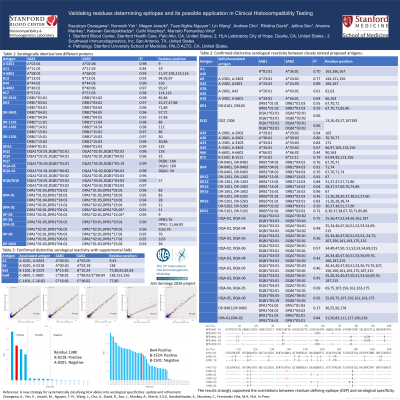Back

Validating residues determining epitopes and its possible application in Clinical Histocompatibility Testing
(P320) Validating residues determining epitopes and its possible application in clinical histocompatibility testing
Location: Platinum Ballroom

Poster Presenter(s)
Aim: We aim to validate computationally predicted serological specificity (serotype), and correlate the specific reactivity with amino acid residues that determines epitopes (DEP).
Method: Mean fluorescence intensity values of a core set of SABs were analyzed by pairwise comparisons in a linear regression model examining the reactivity of sera from >13000 patients. An additional set of supplemental SAB was examined using selected sera. Sera showing unexpected reaction were tested by cell-based assays in order to confirm or rule out possible novel serotypes defined by substitutions at residues thought to be insignificant for the definition of serotypes. The polymorphic residues were associated with serological specificities that differentiate one from other closely related antigens or serotypes.
Results: The currently available SABs were grouped as belonging to the same or different serotypes based the coefficient determination (R2) values. The WHO accepted antigens A26 and A43 that were known to display different serological specificities showed R2 =0.61, therefore, residue positions 62 and 63 were confirmed to be DEP residues. The A*02:01 and A*02:06 showed R2 = 0.98 that suggested that they belong to the same serotype designated as A-0201, therefore, residue position 9 was unlikely involved in the serological specificity. In contrast, A*33:01 and A*33:03 showed R2 =0.83 that indicated that they corresponded to different serotypes, designated as A-3301 and A-3303, respectively and that the residue position 171 is likely associated with the different serological specificities. Of 27 DEP residues considered for defining HLA-A serotypes, we confirmed significantly distinctive serological reactivity for 23 DEPs. Similarly, 22 of 25 and 12 of 14 DEPs for HLA-B and -DR, respectively, were confirmed to define the distinctive serological reactivity.
Conclusion: The results strongly supported the HATS predicted serotypes, although the number of serotypes examined were limited. More data including the supplemental SAB panels may allow pinpointing additional DEP residues, confirming additional serotypes and identifying possible novel serotypes. The future collaborative studies will be in line with the progress made to present for understanding the role of HLA variation in defining HLA incompatibilities and how it has been addressed for optimizing the clinical histocompatibility practices.
Method: Mean fluorescence intensity values of a core set of SABs were analyzed by pairwise comparisons in a linear regression model examining the reactivity of sera from >13000 patients. An additional set of supplemental SAB was examined using selected sera. Sera showing unexpected reaction were tested by cell-based assays in order to confirm or rule out possible novel serotypes defined by substitutions at residues thought to be insignificant for the definition of serotypes. The polymorphic residues were associated with serological specificities that differentiate one from other closely related antigens or serotypes.
Results: The currently available SABs were grouped as belonging to the same or different serotypes based the coefficient determination (R2) values. The WHO accepted antigens A26 and A43 that were known to display different serological specificities showed R2 =0.61, therefore, residue positions 62 and 63 were confirmed to be DEP residues. The A*02:01 and A*02:06 showed R2 = 0.98 that suggested that they belong to the same serotype designated as A-0201, therefore, residue position 9 was unlikely involved in the serological specificity. In contrast, A*33:01 and A*33:03 showed R2 =0.83 that indicated that they corresponded to different serotypes, designated as A-3301 and A-3303, respectively and that the residue position 171 is likely associated with the different serological specificities. Of 27 DEP residues considered for defining HLA-A serotypes, we confirmed significantly distinctive serological reactivity for 23 DEPs. Similarly, 22 of 25 and 12 of 14 DEPs for HLA-B and -DR, respectively, were confirmed to define the distinctive serological reactivity.
Conclusion: The results strongly supported the HATS predicted serotypes, although the number of serotypes examined were limited. More data including the supplemental SAB panels may allow pinpointing additional DEP residues, confirming additional serotypes and identifying possible novel serotypes. The future collaborative studies will be in line with the progress made to present for understanding the role of HLA variation in defining HLA incompatibilities and how it has been addressed for optimizing the clinical histocompatibility practices.

